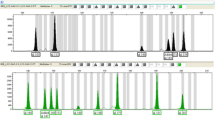Abstract
The present study demonstrates utilization of 11 microsatellite markers to explore genetic diversity held in Perilla frutescens (L.) Britt. landrace accessions growing on farms in different parts of Korea and Japan and to assess their genetic relationships. All microsatellite loci were polymorphic and produced a total of 96 alleles ranging from 4 to 20, with an average of 8.7 alleles per locus. Of the 96 alleles found, a total of 15 unique landrace-specific alleles were observed at 9 different loci. The locus GBPFM203 provided the highest number of alleles (20), of which five were unique and each specific to a particular landrace accession. The occurrence of unique, accession-specific alleles presented molecular evidence for the generation of new alleles within on-farm collection of Perilla. The mean values of observed (H O) and expected heterozygosity (H E) were 0.39 and 0.68, respectively, indicating a considerable amount of polymorphism within this collection. A genetic distance-based phylogeny grouped the two Perilla varieties, var. frutescens and var. crispa (Thunb.) Decne into two distinct groups. Accessions belonging to var. frutescens could also be divided into two subgroups at a close genetic distance (GD = 0.432). The overall clustering pattern did not strictly follow the grouping of accessions according to their geographic origins. These observations are indicative of extensive germplasm exchange among farms from different geographical regions. The genetic similarity observed among the Perilla landraces may be useful for future Perilla crop variety identification, conservation, and improvement programs.


Similar content being viewed by others
References
Dixit A, Jin MH, Chung JW, Yu JW, Chung HK, Ma KH, Park YJ, Cho EG (2005) Development of polymorphic microsatellite markers in sesame (Sesamum indicum L.). Mol Ecol Notes 5:736–738
Duke JA, Ayensu ES (1985) Medicinal plants of China. Reference Publ., Algonac, MI
Ellegren H (2004) Microsatellites: simple sequences with complex evolution. Nat Genet 5:435–445
Frankel OH, Soule ME (1981) Conservation and evolution. Cambridge University Press, Cambridge
Harlan JR (1975) Our vanishing genetic resources. Science 188:618–621
Honda G, Koezuka Y, Tabita M (1990) Genetic studies of fruit color and hardness in Perilla frutescens. Jpn J Breed 40:469–474
Honda G, Yuba A, Kojima T, Tabata M (1994) Chemotaxonomic and cytogenetic studies on Perilla frutescens var. citiodora (“Lemon Egoma”). Nat Med 48:185–190
Jarne J, Lagoda JL (1996) Microsatellites—from molecules to populations and back. Trends Ecol Evol 11:424–429
Kim KY (2004) Developing one step program (SSR Manager) for rapid identification of clones with SSRs and primer designing. M.Sc. dissertation, Seoul National University, Seoul, Republic of Korea
Kumar S, Tamura K, Nei M (2004) MEGA3: integrated software for molecular evolutionary genetics analysis and sequence alignment. Brief Bioinfor 5:150–163
Kwon SJ, Lee JK, Kim NS, Yu JW, Dixit A, Cho EG, Park YJ (2005) Isolation and characterization of microsatellite markers in Perilla frutescens Britt. Mol Ecol Notes 5:454–456
Lee JK, Nitta M, Kim NS, Park CH, Yoon KM, Shin YB, Ohnishi O (2002) Genetic diversity of Perilla and related weedy types in Korea determined by AFLP analyses. Crop Sci 42:2161–2166
Lee JK, Ohnishi O (2001) Geographical differentiation of morphological characters among Perilla crops and their weedy types in East Asia. Breed Sci 51:247–255
Lee JK, Ohnishi O (2003) Genetic relationships among cultivated types of Perilla frutescens and their weedy types in East Asia revealed by AFLP markers. Genet Resour Crop Evol 50:65–74
Liu K, Muse SV (2005) PowerMarker: an integrated analysis environment for genetic marker analysis. Bioinformatics 21:2128–2129
Mohan M, Nair S, Krishna TG, Yano M, Rhodes I (1997) Genome mapping, molecular markers and marker-assisted selection in crop plants. Mol Breed 3:87–103
Makino T (1961) Makino’s new illustrated flora of Japan. Hokuryu-kan, Tokyo (in Japanese)
Nagai I (1935) On “Shiso” and “Egoma.” Agricult Horticult 10:2265–2273
Nitta M, Lee JK, Kobayashi H, Liu D, Nagamine T (2005) Diversification of multipurpose plant, Perilla frutescens. Genet Resour Crop Evol 52:663–670
Nitta M, Lee JK, Ohnishi O (2003) Asian Perilla crops and their weedy forms: their cultivation, utilization and genetic relationships. Econ Bot 57:245–253
Nitta M, Ohnishi O (1999) Genetic relationships among two Perilla crops, shiso and egoma, and the weedy type revealed by RAPD markers. Genes Genet Syst 74:43–48
Park YJ, Dixit A, Ma KH, Kang JH, Rao VR, Cho EG (2005) On-farm conservation strategy to ensure crop genetic diversity in changing agro-ecosystems in the Republic of Korea. J Agrn Crop Sci 191:401–410
Perry LM (1980) Medicinal plants of East and South-East Asia: attributed properties and uses. MIT Press, Cambridge, MA
Powell W, Maachray GC, Proven J (1996) Polymorphism revealed by simple sequence repeats. Trends Plant Sci 1:215–222
Rao NK (2004) Plant genetic resources: advancing conservation and use through biotechnology. Afr J Biotechnol 3:136–145
Schuelke M (2000) An economic method for the fluorescent labeling of PCR fragments. Nat Biotechnol 18:233–234
Villa TCC, Maxted N, Scholten M, Ford-Lloyd B (2006) Defining and identifying crop landraces. Plant Genet Resour 3:373–384
Yeh FC, Yang RC, Boyle TJB (1999) Popgene version 1.31. Microsoft window-based freeware for population genetic analysis. University of Alberta and Centre for International Forestry Research, Edmonton, AB, Canada
Zeven AC (1998) Landraces: a review of definitions and classifications. Euphytica 104:127–139
Zizumbo-Villarreal D, Colunga-Garcia Marin P, Payro de la Cruz E, Delgado-Valerio P, Gepts P (2005) Population structure and evolutionary dynamics of wild-weedy-domesticated complexes of common bean in a Mesoamerican region. Crop Sci 45:1073–1083
Acknowledgements
This work was supported by a grant (Code # 20050401034738) from the Bio-Green 21 program, Rural Development Administration (RDA), Republic of Korea and Bioversity International under Consultative Groups on International Agricultural Research (CGIAR).
Author information
Authors and Affiliations
Corresponding author
Rights and permissions
About this article
Cite this article
Park, YJ., Dixit, A., Ma, KH. et al. Evaluation of genetic diversity and relationships within an on-farm collection of Perilla frutescens (L.) Britt. using microsatellite markers. Genet Resour Crop Evol 55, 523–535 (2008). https://doi.org/10.1007/s10722-007-9258-x
Received:
Accepted:
Published:
Issue Date:
DOI: https://doi.org/10.1007/s10722-007-9258-x




